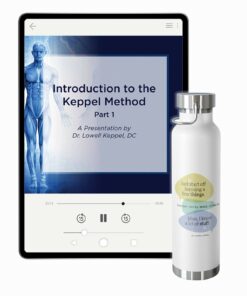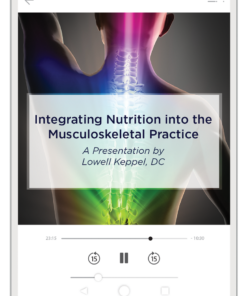Enjoy the latest installment of Dr. Lowell Keppel’s Tip of the Month series by Dr. Royal Lee for practitioners.
During the late 1950s and into the 1970s, Standard Process published the Applied Trophology newsletter. To this day, it is still an important resource full of exceptional information for the practitioner. One of my favorite recurring features in the newsletter is the “Tip of the Month” from Dr. Royal Lee, which ran from 1957 to 1960.
Let’s look at what Dr. Lee shared with us in the second half of 1959.
Tip of the Month (Cramps)—July 1959
“Muscular cramps denote unbalanced blood chemistry. Natural vitamin K, as found in Standard Process Chlorophyll Complex Perles, is a specific remedy to restore balance.”
Interesting that Dr. Lee is talking about cramps and Chlorophyll Complex. He also noted of chlorophyll that it neutralizes guanidine (an alkaline toxic substance that precipitates calcium) upon contact. (You can read more about guanidine and its effect on calcium at the SRP Historical Archives.) So by neutralizing guanidine with chlorophyll, you can “protect” calcium.
Recent research shows that vitamin K, specifically K2, also has an effect on proteins and calcium. The body routinely converts the vitamin K in chlorophyll to vitamin K2. Although vitamin K exists in some fermented foods, its primary source is the body’s natural conversion of vitamin K into K2 as needed. If you have adequate chlorophyll from vitamin K-rich dark green leafy vegetables and animal organs, getting enough K2 should be of no concern. A simple test for vitamin K adequacy is blood-clotting time from a sterile finger prick. The blood should clot in two minutes. For more on the therapeutic role of vitamin K in patients with cramps, refer to this study.
Click here for the complete July 1959 issue of Applied Trophology.
Tip of the Month (Bee Sting)—August 1959
“Two Cal-Amo tablets swallowed with water at half-hour intervals will stop the swelling of bee sting and completely relieve the pain in less than two hours. Even quicker results are obtained by dissolving the tablet and applying to the sting.”
Cal-Amo is an acidifying product. The venom from a bee sting is slightly acidic, but the real issue is the histamine reaction that occurs as a result of tissue destruction from the venom. Dr. Lee talks about histamine reaction resulting from too much alkalinity, in this case alkaline at the sting site. Let’s neutralize the histamine by acidifying the injured tissues with a Cal-Amo poultice.
Click here for the complete August 1959 issue of Applied Trophology.
Tip of the Month (Hemorrhage)—September 1959
“To stop bleeding in a victim of hereditary hemophilia or in sporadic hemorrhage, the chewing of two Chlorophyll Perles, and swallowing of two more immediately after that, will in most instances rapidly stop the bleeding. Where blood calcium is deficient, Calcium Lactate may also be necessary to check the hemorrhage.
“Pneumotrophin remains our standby control in the usual types of hemorrhage, and we use Ovex specifically for uterine bleeding.”
Chlorophyll Perles (now Chlorophyll Complex) are a great source of vitamin K, which is essential for prothrombin formation. Vitamin K activates calcium into the prothrombin production.
Dr. Lee also references Ovex for heavy menses. Woman who bleed too much often have too much estrogen. Ovex plays a role in stimulating progesterone production, which normalizes the menstrual cycle.
Click here for the complete September 1959 issue of Applied Trophology.
Tip of the Month (Tic Douloureux)—October 1959
“Tic douloureux has often been found to respond to the use of vitamin B12. Because B12 can be used in high doses without danger, this distressing condition should be experimentally treated with high doses of this vitamin. If B12 deficiency is responsible, prompt improvement will follow.”
In the Index of The Product Bulletins, Dr. Lee notes: “Aside from its well-known effect as antianemia factor, B12 seems to serve well where neurological aspects are concerned, particularly in relation to cerebral involvements, the effect here probably due to improvement in oxygenation mechanisms.”
Remember, tic douloureux is an issue with the trigeminal nerve (the fifth cranial nerve). Dr. Lee’s theory is that the nerve is losing its myelin sheath. B12 helps maintain that. Thanks to Dr. Lee, we also know that arachidonic acid, vitamin F2, found in Super-EFF, protects and restores the myelin sheath. So Super-EFF and Cataplex B12 might deliver great results.
Click here for the complete October 1959 issue of Applied Trophology.
Tip of the Month (Oily Skin)—November/December 1959 
“Oily skin is a common reaction to vitamin G deficiency.”
This little gem is an observational sign. Cataplex G is the lipotropic portion of the B vitamin family. It is necessary for liver function, which effects fat metabolism. Cataplex G contains riboflavin (B2), which also has a great effect on the skin. This is well documented in medical literature.
The next time a patient complains of oily skin, leg check that patient, and recommend six tablets of Cataplex G per day!
Click here for the complete November/December 1959 issue of Applied Trophology.
I just love the Tip of the Month feature from Dr. Lee. When I am talking to patients, I can call on these tips to help me figure out what products to use. I look forward to sharing more of Dr. Lee’s gems from 1960!
Images from iStock//BrianAJackson (main), PKpix (bee sting), Alona Siniehina (woman looking at her face).







